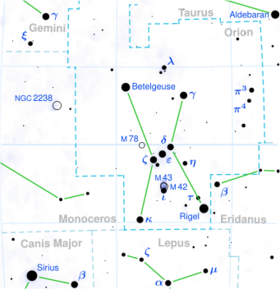Astronomy:49 Orionis
| Observation data Equinox J2000.0]] (ICRS) | |
|---|---|
| Constellation | Orion |
| Right ascension | 05h 38m 53.08332s[1] |
| Declination | −07° 12′ 46.1667″[1] |
| Apparent magnitude (V) | 4.80[2] |
| Characteristics | |
| Evolutionary stage | main sequence |
| Spectral type | A4Vn[3] |
| U−B color index | +0.11[2] |
| B−V color index | +0.13[2] |
| Astrometry | |
| Radial velocity (Rv) | −5.30[4] km/s |
| Proper motion (μ) | RA: −15.562[1] mas/yr Dec.: −50.613[1] mas/yr |
| Parallax (π) | 23.1346 ± 0.2801[1] mas |
| Distance | 141 ± 2 ly (43.2 ± 0.5 pc) |
| Absolute magnitude (MV) | 1.52[5] |
| Details | |
| Mass | 1.78[6] M☉ |
| Radius | 2.0[7] R☉ |
| Luminosity | 22[8] L☉ |
| Surface gravity (log g) | 4.06[6] cgs |
| Temperature | 8,416±286[6] K |
| Rotational velocity (v sin i) | 186[8] km/s |
| Age | 284[6] Myr |
| Other designations | |
| Database references | |
| SIMBAD | data |
49 Orionis is a single[10] star in the equatorial constellation of Orion. It has the Bayer designation d Orionis, while 49 Orionis is the Flamsteed designation. This object is visible to the naked eye as a faint, white-hued star with an apparent visual magnitude of 4.80.[2] It is located 141 light years away from the Sun based on parallax,[1] but is drifting closer with a radial velocity of −5 km/s.[4]
In the past 49 Orionis was reported as a spectroscopic binary and an orbit was computed with a period of 445.74 days and an eccentricity of 0.549.[11] But it was later determined to be single.[10]
This object is an A-type main-sequence star with a stellar classification of A4Vn,[3] where the 'n' suffix indicates broadened "nebulous" lines caused by rapid rotation. It is around 284[6] million years old with a projected rotational velocity of 186 km/s.[8] This spin is giving the star an oblate shape with an equatorial bulge that is an estimated 8% larger than the polar radius.[12] The star has 1.8[6] times the mass of the Sun and double[7] the Sun's radius. It is radiating 22[8] times the Sun's luminosity from its photosphere at an effective temperature of 8,416 K.[6]
References
- ↑ 1.0 1.1 1.2 1.3 1.4 1.5 Brown, A. G. A. (August 2018). "Gaia Data Release 2: Summary of the contents and survey properties". Astronomy & Astrophysics 616: A1. doi:10.1051/0004-6361/201833051. Bibcode: 2018A&A...616A...1G. Gaia DR2 record for this source at VizieR.
- ↑ 2.0 2.1 2.2 2.3 Ducati, J. R. (2002). "VizieR Online Data Catalog: Catalogue of Stellar Photometry in Johnson's 11-color system". CDS/ADC Collection of Electronic Catalogues 2237. Bibcode: 2002yCat.2237....0D.
- ↑ 3.0 3.1 Gray, R. O.; Garrison, R. F. (July 1989). "The Late A-Type Stars: Refined MK Classification, Confrontation with Stroemgren Photometry, and the Effects of Rotation". Astrophysical Journal Supplement 70: 623. doi:10.1086/191349. Bibcode: 1989ApJS...70..623G.
- ↑ 4.0 4.1 Gontcharov, G. A. (2006). "Pulkovo Compilation of Radial Velocities for 35 495 Hipparcos stars in a common system". Astronomy Letters 32 (11): 759–771. doi:10.1134/S1063773706110065. Bibcode: 2006AstL...32..759G.
- ↑ Anderson, E.; Francis, Ch. (2012). "XHIP: An extended hipparcos compilation". Astronomy Letters 38 (5): 331. doi:10.1134/S1063773712050015. Bibcode: 2012AstL...38..331A. Vizier catalog entry
- ↑ 6.0 6.1 6.2 6.3 6.4 6.5 6.6 David, Trevor J.; Hillenbrand, Lynne A. (2015), "The Ages of Early-Type Stars: Strömgren Photometric Methods Calibrated, Validated, Tested, and Applied to Hosts and Prospective Hosts of Directly Imaged Exoplanets", The Astrophysical Journal 804 (2): 146, doi:10.1088/0004-637X/804/2/146, Bibcode: 2015ApJ...804..146D.
- ↑ 7.0 7.1 Allende Prieto, C.; Lambert, D. L. (1999). "Fundamental parameters of nearby stars from the comparison with evolutionary calculations: Masses, radii and effective temperatures". Astronomy and Astrophysics 352: 555–562. Bibcode: 1999A&A...352..555A. Vizier catalog entry
- ↑ 8.0 8.1 8.2 8.3 Zorec, J.; Royer, F. (2012). "Rotational velocities of A-type stars". Astronomy & Astrophysics 537: A120. doi:10.1051/0004-6361/201117691. Bibcode: 2012A&A...537A.120Z. Vizier catalog entry
- ↑ "49 Ori". SIMBAD. Centre de données astronomiques de Strasbourg. http://simbad.u-strasbg.fr/simbad/sim-basic?Ident=49+Ori.
- ↑ 10.0 10.1 De Rosa, R. J. et al. (2014). "The VAST Survey - III. The multiplicity of A-type stars within 75 pc". Monthly Notices of the Royal Astronomical Society 437 (2): 1216. doi:10.1093/mnras/stt1932. Bibcode: 2014MNRAS.437.1216D.
- ↑ Abt, Helmut A. (June 1965). "The Frequency of Binaries among Normal A-Type Stars". Astrophysical Journal Supplement 11: 429. doi:10.1086/190120. Bibcode: 1965ApJS...11..429A.
- ↑ Belle, G. T. (2012), "Interferometric observations of rapidly rotating stars", The Astronomy and Astrophysics Review 20 (1): 51, doi:10.1007/s00159-012-0051-2, Bibcode: 2012A&ARv..20...51V.
 |



